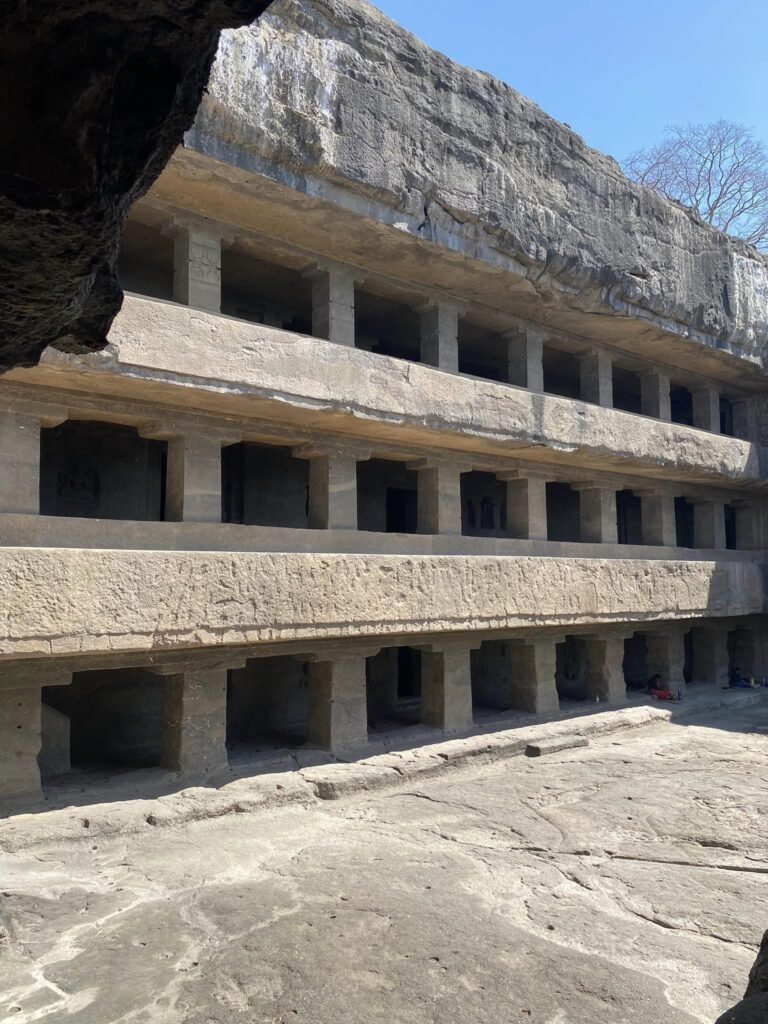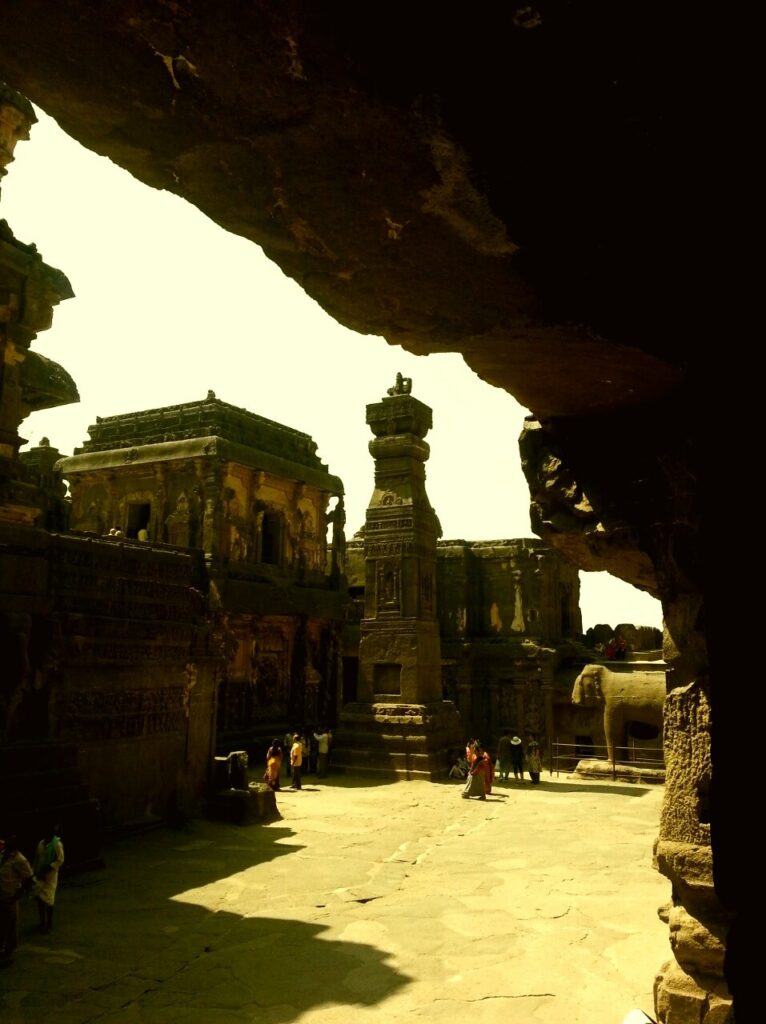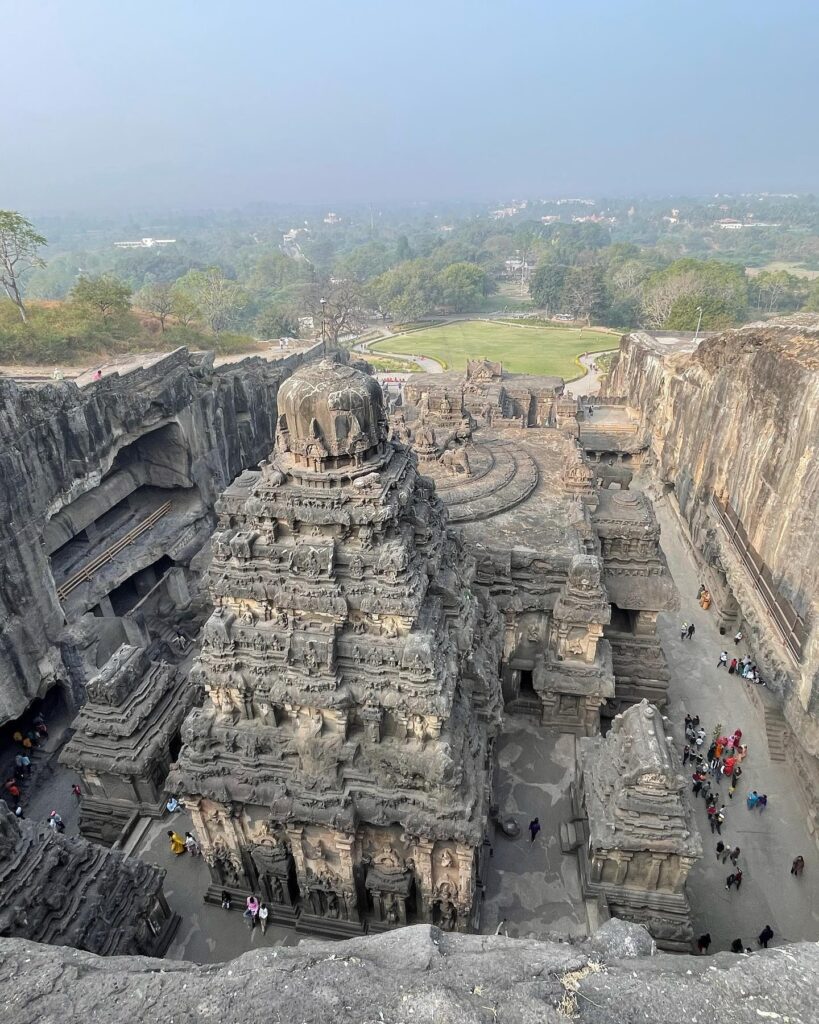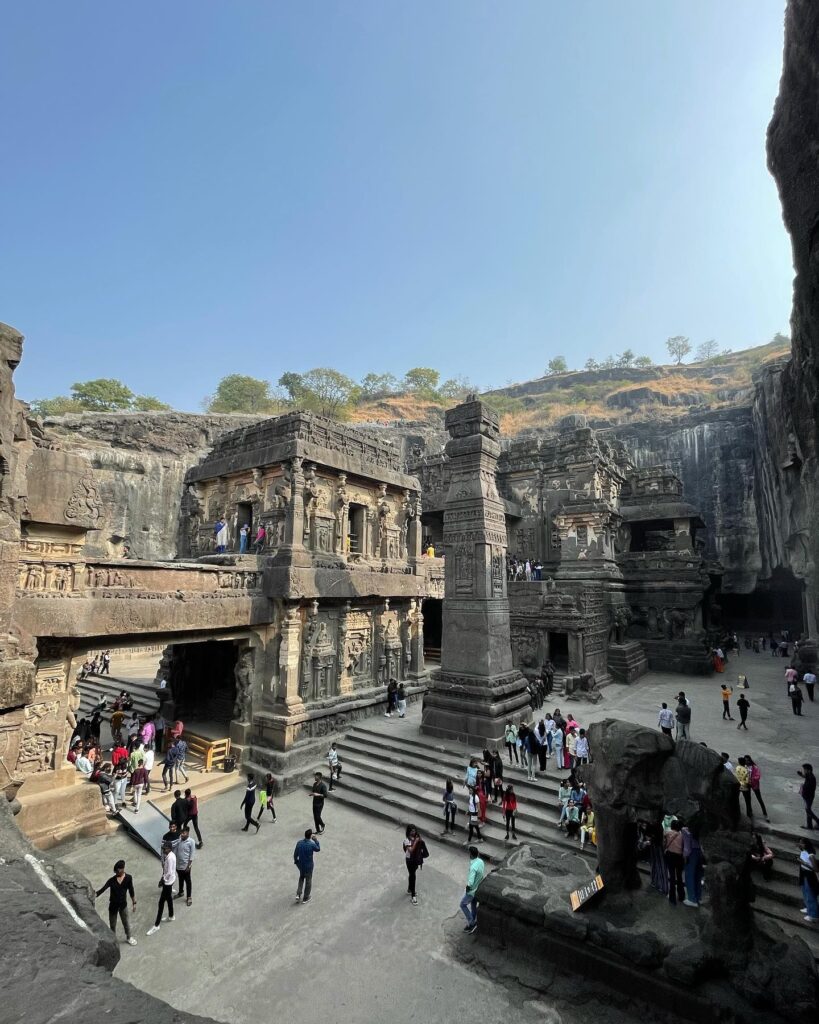The Ellora Caves are an archaeological site located in the state of Maharashtra in India, near Aurangabad, and which is classified as a UNESCO World Heritage Site. Ellora is often visited in combination with the Ajanta Caves, and the two places are separated by a hundred kilometers and are complexes of temples and monasteries carved into the cliffs.

Ellora is made up of 36 caves. What is really crazy is that these caves were carved by hand. Some are not caves but rock-cut structures, such as the Kailash (or Kailasa) temple in Ellora, which is the largest monolithic structure in the world! While Ellora is renowned for its architecture, Ajanta itself contains magnificent paintings dating from 200 BC to 650 AD. The Ellora Caves were carved between the 6th and 11th centuries, after Ajanta was abandoned .
The caves in Ajanta are all Buddhist while that of Ellora is a mixture of Buddhism, Hinduism and Jainism.

Ajanta and Ellora Caves are accessible from the city of Aurangabad which is about 300km from Mumbai.
By air: Aurangabad airport is 15km away and can be reached directly from Delhi, Mumbai, Jaipur, Udaipur, Hyderabad.
By train: the nearest railway station is in Aurangabad, and there are regular trains from Mumbai, Hyderabad, Delhi, Pune, Amritsar and other destinations. There is an overnight train from Mumbai to Aurangabad.
By bus: Aurangabad to an interstate bus station. Many buses go to Ellora and Ajanta (100 rupees one way to Ajanta, 2h15 drive) but the most reliable are the government buses of the Maharashtra State Tourism Corporation (MTDC).
By Taxi: Available from Aurangabad. On the way to Ellora you can stop at Daulatabad Fort.
Ellora is 29 km from Aurangabad, and Ajanta about 108 km to the southwest.

Entrance to Ellora costs 600 Rupees (7 Euros), and there is a supplement to pay if you want to film but not for photos (although with digital cameras filming I wonder how they can check).

Ajanta and Ellora are open from 9:00 a.m. to 5:30 p.m.
Ellora Caves are closed on Tuesdays, and Ajanta Caves on Mondays.
October to March is a good time to visit the caves, the temperatures are not as extreme as in summer, it is around 22°c during the day and 10°c at night. However even in summer it can get cold at night if you sleep in Aurangabad. The monsoon is from June to October but the rain falls moderately and the landscape is prettier, especially towards Ajanta (see photos on google taken at this time).
Try to avoid going there on weekends or during national holidays, otherwise it will be full of tourists. Also remember to take a lamp with you.

Considered by some to be the Indian equivalent of Petra in Jordan, the Ellora Caves do not benefit from the same landscape as its neighbor Ajanta but are just as spectacular and compensate with a large number of sculptures. In total, there are 34 Buddhist, Hindu and Jainist caves, which were sometimes excavated at the same time.
This site became a center of religious and artistic activity as a trade route passed alongside to towns in the north and ports on the west coast. It was initially the merchants attracted by a religion without castes or social discrimination who financed the creation of Ellora, the caves being at the beginning refuges for the Buddhist monks when it rained, then were transformed into temples and monasteries as and as you go. Construction began when Ajanta, located 100km away, was abandoned, when it was the ‘beginning of the end’ of Buddhism in central India, later replaced by Hinduism. , then by Jainism towards the end of the first millennium.
Unlike Ajanta, Ellora did not escape the destruction made by Muslim iconoclasts in the 13th century. However the best sculptures have been well preserved.

As in Ajanta the caves are numbered, but in chronological order. To see the oldest caves first, go straight to the right when you are facing the Kailash temple. The more you progress along the caves, the more they will become impressive in size.
Best to save the best for the late afternoon when everyone has left and is lit by the setting sun, i.e. the visit to the colossal Kailash temple, set in a huge hollowed-out cavity in the cliff into a complex of halls, galleries and sanctuaries. This is truly Ellora’s masterpiece, and even the most jaded traveler should be amazed by the sheer scale of the monument.
Kailash is not a cave strictly speaking but a gigantic sculpture carved into the hill. It is possible to see it from above from the top of the hill.
It is said that it was imagined by King Krishna 1st (756-773) and that it took nearly 100 years to complete.

Its construction began by digging all the way up the hill to the bottom. In total, it is estimated that around 500,000 tons of debris was evacuated from the hill for its construction, with no room for improvisation or the slightest error. The temple was designed as a giant replica of a divine Tibetan mountain. In the past, it was covered with white lime but its color has almost disappeared over time.







Ellora Caves BY DELIGHTED JOURNEY
The Ellora Caves are an archaeological site located in the state of Maharashtra in India, near Aurangabad, and which is classified as a UNESCO World Heritage Site. Ellora is often visited in combination with the Ajanta Caves, and the two places are separated by a hundred kilometers and are complexes of temples and monasteries carved into the cliffs.

Ellora is made up of 36 caves. What is really crazy is that these caves were carved by hand. Some are not caves but rock-cut structures, such as the Kailash (or Kailasa) temple in Ellora, which is the largest monolithic structure in the world! While Ellora is renowned for its architecture, Ajanta itself contains magnificent paintings dating from 200 BC to 650 AD. The Ellora Caves were carved between the 6th and 11th centuries, after Ajanta was abandoned .
The caves in Ajanta are all Buddhist while that of Ellora is a mixture of Buddhism, Hinduism and Jainism.

Ajanta and Ellora Caves are accessible from the city of Aurangabad which is about 300km from Mumbai.
By air: Aurangabad airport is 15km away and can be reached directly from Delhi, Mumbai, Jaipur, Udaipur, Hyderabad.
By train: the nearest railway station is in Aurangabad, and there are regular trains from Mumbai, Hyderabad, Delhi, Pune, Amritsar and other destinations. There is an overnight train from Mumbai to Aurangabad.
By bus: Aurangabad to an interstate bus station. Many buses go to Ellora and Ajanta (100 rupees one way to Ajanta, 2h15 drive) but the most reliable are the government buses of the Maharashtra State Tourism Corporation (MTDC).
By Taxi: Available from Aurangabad. On the way to Ellora you can stop at Daulatabad Fort.
Ellora is 29 km from Aurangabad, and Ajanta about 108 km to the southwest.

Entrance to Ellora costs 600 Rupees (7 Euros), and there is a supplement to pay if you want to film but not for photos (although with digital cameras filming I wonder how they can check).

Ajanta and Ellora are open from 9:00 a.m. to 5:30 p.m.
Ellora Caves are closed on Tuesdays, and Ajanta Caves on Mondays.
October to March is a good time to visit the caves, the temperatures are not as extreme as in summer, it is around 22°c during the day and 10°c at night. However even in summer it can get cold at night if you sleep in Aurangabad. The monsoon is from June to October but the rain falls moderately and the landscape is prettier, especially towards Ajanta (see photos on google taken at this time).
Try to avoid going there on weekends or during national holidays, otherwise it will be full of tourists. Also remember to take a lamp with you.

Considered by some to be the Indian equivalent of Petra in Jordan, the Ellora Caves do not benefit from the same landscape as its neighbor Ajanta but are just as spectacular and compensate with a large number of sculptures. In total, there are 34 Buddhist, Hindu and Jainist caves, which were sometimes excavated at the same time.
This site became a center of religious and artistic activity as a trade route passed alongside to towns in the north and ports on the west coast. It was initially the merchants attracted by a religion without castes or social discrimination who financed the creation of Ellora, the caves being at the beginning refuges for the Buddhist monks when it rained, then were transformed into temples and monasteries as and as you go. Construction began when Ajanta, located 100km away, was abandoned, when it was the ‘beginning of the end’ of Buddhism in central India, later replaced by Hinduism. , then by Jainism towards the end of the first millennium.
Unlike Ajanta, Ellora did not escape the destruction made by Muslim iconoclasts in the 13th century. However the best sculptures have been well preserved.

As in Ajanta the caves are numbered, but in chronological order. To see the oldest caves first, go straight to the right when you are facing the Kailash temple. The more you progress along the caves, the more they will become impressive in size.
Best to save the best for the late afternoon when everyone has left and is lit by the setting sun, i.e. the visit to the colossal Kailash temple, set in a huge hollowed-out cavity in the cliff into a complex of halls, galleries and sanctuaries. This is truly Ellora’s masterpiece, and even the most jaded traveler should be amazed by the sheer scale of the monument.
Kailash is not a cave strictly speaking but a gigantic sculpture carved into the hill. It is possible to see it from above from the top of the hill.
It is said that it was imagined by King Krishna 1st (756-773) and that it took nearly 100 years to complete.

Its construction began by digging all the way up the hill to the bottom. In total, it is estimated that around 500,000 tons of debris was evacuated from the hill for its construction, with no room for improvisation or the slightest error. The temple was designed as a giant replica of a divine Tibetan mountain. In the past, it was covered with white lime but its color has almost disappeared over time.







Ellora Caves BY DELIGHTED JOURNEY
Copyright © 2025 Delighted Journey | All Rights Reserved.